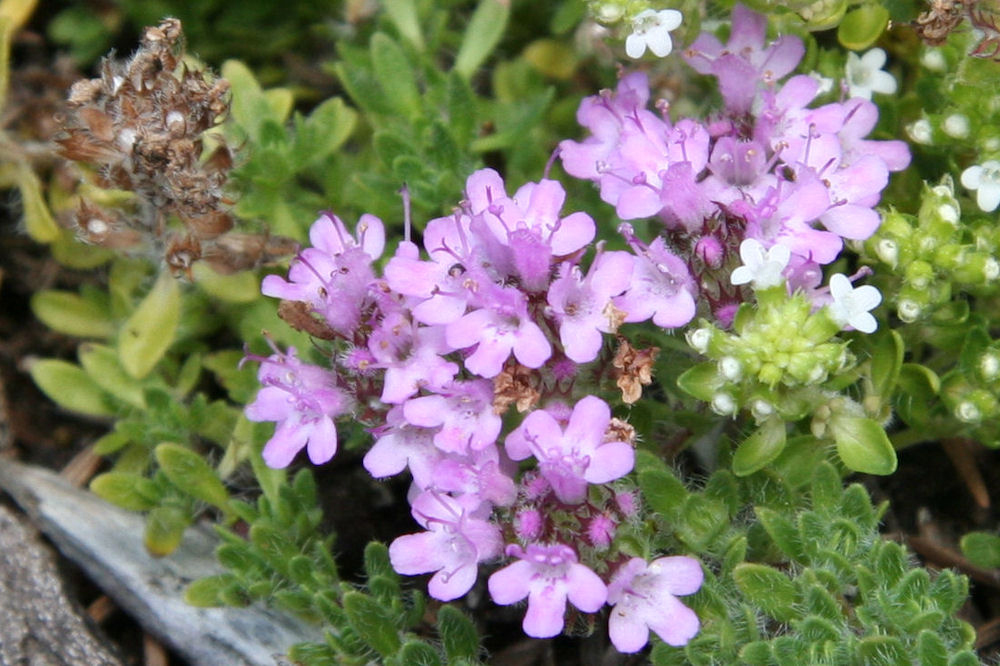

The petiole attaches at the basal margin of the leaf blade The hairs are standing up straight or curved in different directions The leaves are green, with an expanded blade and a leaf-like texture The leaves drop off in winter (or they whither but persist on the plant)

The upper side of the leaf blade is relatively uniform in color the leaf blade is linear (very narrow with more or less parallel sides).the leaf blade is elliptic (widest near the middle and tapering at both ends).

The leaf blade has tangled or woolly-looking hairs The edge of the leaf blade is entire (has no teeth or lobes) The genus Thymus contains about 350 species of aromatic perennial herbaceous plants and subshrubs to 40 cm tall in the family Lamiaceae, native to temperate regions in Europe, North Africa and Asia. the base of the leaf blade is cuneate (wedge-shaped, tapers to the base with relatively straight, converging edges), or narrow.The leaf has a distinct leaf stalk (petiole) Opposite: there are two leaves per node along the stem The upper side of the leaf is fuzzy or hairy The underside of the leaf is fuzzy or hairy The flower has one or more bracts associated with it The fruits do not have thorn-like defensive structuresįinal leaf segment length (compound lvs only)įinal leaf segment length to width ratio (compound lvs only)įinal leaf segment width (compound lvs only) The plant has axile placentation, in which the ovules are attached where the septa of a compound ovary are united, usually on the central axis, or to the septa themselves The fruit is a schizocarp (when dry it splits into sections, each holding one or more seeds) The fruit is dry but does not split open when ripe the upper lip of the bilabiate corolla has two lobes.the upper lip of the bilabiate corolla has one lobe.The stamens are not attached to one another The stamens are attached at or near the bases of the petals or tepals The sepals are fused to each other (not other flower parts), at least near their bases One or more of the sepals is much narrower or shorter than the others the sepal outline is linear (extremely narrow, thread-like).the sepal outline is eliiptic (widest near the middle and tapering at both ends).The sepals do not have appendages on them The sepals are green or brown, and leaf-like in texture The petals of the flower do not have folds or plaitsĪll the flowers have both carpels and stamens (synoecious) The petals are thin and delicate, and pigmented (colored other than green or brown) The flower includes two cycles of petal- or sepal-like structures The ovary is above the point of petal and/or sepal attachment There are five petals, sepals, or tepals in the flower The flowers are arrayed in a spiral around the inflorescence axis or branches, or occur singly, or in several ranks The petals or the sepals are fused into a cup or tube There is only one way to evenly divide the flower (the flower is bilaterally symmetrical) the flower has either only pollen- or only seed-producing parts.the flower has both pollen- and seed-producing parts.The flower has a superior ovary, and lacks a hypanthium There are no cleistogamous flowers on the plan If your soil is heavy, add horticultural grit to the soil before planting to improve drainage.There is only one way to evenly divide the calyx (the calyx is bilaterally symmetrical) Thyme plant is fully hardy, but don’t like their roots in wet soil, especially in winter. Thymus vulgaris Thymus vulgaris in open ground Overwinter Lightly trim after flowering to keep it in nice shape. Don’t cut back into leafless woody stems. Shorten stems by 5-7cm, pruning above a set of green leaves. Cut back after flowering to keep the plant compact and to promote plenty of new growth. Pruning Thyme Flowers on Thymus vulgaris Pruning ‘Snowdrift’ is white-flowering, whereas ‘Silver Posie’ bears purple flowers with grey-green, white-margined leaves. Thymus serpyllum (creeping thyme) is a dwarf, evergreen shrub, producing masses of soft pink flowers in summer above dark green leaves. Thymus serpyllumĬreeping thyme is ideal for edging paths and suitable for cracks in paving. Thymus citriodorusįor lemon-scented leaves try Thymus citriodorus or Thymus ‘Lemon Variegated’. The aromatic foliage is often used for adding flavour to the soup, meat, vegetables, especially tomatoes. It is an undemanding plant, easy to grow in a pot. Thymus vulgaris (common thyme) is one of the best known of all thyme varieties and for good reason. There are many different varieties of thyme. Thymes are small plants and are grown for their aromatic leaves. Hardiness: fully hardy Varieties Thymus vulgaris


 0 kommentar(er)
0 kommentar(er)
